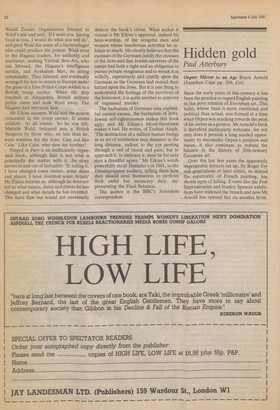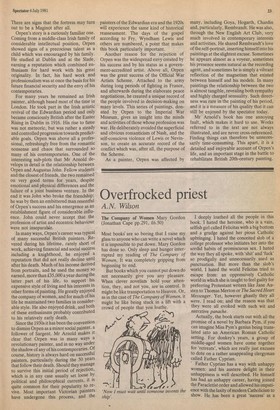Hidden gold
Paul Atterbury
Orpen: Mirror to an Age Bruce Arnold (Jonathan Cape pp. 294, £16) Since the early years of this century it has been the practice to regard English painting as the poor relation of European art. This habit, whose basis is more emotional and political than actual, was formed at a time when Orpen was reaching towards the peak of his career as a painter. Mr Arnold's book is therefore particularly welcome, for not only does it provide a long needed opportunity to reconsider Orpen's position and status, it also continues to redress the balance in the history of 20th-century European art.
Over the last few years the apparently impregnable fortress set up, by Roger Fry and generations of later critics, to defend the superiority of French painting, has shown signs of falling. Events like the Post Impressionism and Stanley Spencer exhibitions have widened the breach and now Mr Arnold has opened fire on another front. There are signs that the fortress may turn out to be a Maginot after all.
Orpen's story is a curiously familiar one. Coming from a middle-class Irish family of considerable intellectual position, Orpen showed signs of a precocious talent as a child which was encouraged by his family.
He studied at Dublin and at the Slade, earning a reputation which combined enthusiasm for hard work with his great originality. In fact, his hard work and professionalism was at once the basis for his future financial security and the envy of his contemporaries.
For many years he remained an Irish painter, although based most of the time in London. He took part in the Irish artistic revival of the Edwardian period and only became consciously British after the Easter Rising in Dublin in 1916. His rise to fame was not meteoric, but was rather a steady and controlled progression towards predict able goals. Orpen was above all a profes sional, refreshingly free from the romantic nonsense and chaos that surrounded so many of his contemporaries. One of the interesting sub-plots that Mr Arnold develops in detail is the relationship between Orpen and Augustus John. Fellow students and the closest of friends, the two remained on very good terms for years, despite emotional and physical differences and the failure of a joint business venture. In the end it was John who broke the friendship; he was by then an embittered man resentful of Orpen's success and his emergence as an establishment figure of considerable influence. John could never accept that the profession of artist and eccentric behaviour were not inseparable.
In many ways, Orpen's career was typical of many successful British painters. Re vered during his lifetime, rarely short of work, achieving financial and social success including a knighthood, he enjoyed a reputation that did not really decline until after his death. Much of his income derived from portraits, and he used the money so earned, more than £35,000 a year during the latter part of his life, to support his expensive style of living and his interests in other forms of painting. He greatly enjoyed the company of women, and for much of his life he maintained two families in consider able style. He also enjoyed drink, and both of these enthusiasms probably contributed to his relatively early death. Since the 1930s it has been the convention to dismiss Orpen as a minor social painter, a follower of Sargent. Mr Arnold makes it clear that Orpen was in many ways a revolutionary painter, and in no way under the shadow of any of his contemporaries. Of course, history is always hard on successful painters, particularly during the 50 years that follow their death. Should they manage to survive this initial period of rejection, which is in any case usually set loose by political and philosophical currents, it Is quite common for their popularity to revive. Most important Victorian painters have undergone this process, and the painters of the Edwardian era and the 1920s will experience the same kind of historical reassessment. The days of the gospel according to Fry, Wyndham Lewis and others are numbered, a point that makes this book particularly important.
Another reason for the rejection of Orpen was the widespread envy created by his success and by his status as a government-accredited artist. Above all, Orpen was the great success of the Official War Artists Scheme. Attached to the army during long periods of fighting in France, and afterwards during the elaborate peace negotiations, he created a unique record of the people involved in decision-making on many levels. This series of paintings, donated by Orpen to the Imperial War Museum, gives an insight into the minds and activities of those whose profession was war. He deliberately avoided the superficial and obvious romanticism of Nash, and the self-conscious violence of Lewis or Nevinson, to create an accurate record of the conflict which was, after all, the purpose of the Scheme.
As a painter, Orpen was affected by many, including Goya, Hogarth, Chardin and, particularly, Rembrandt. He was also, through the New English Art Club, very much involved in contemporary interests and activities. He shared Rembrandt's love of the self-portrait, inserting himself into his paintings at the slightest excuse. Sometimes he appears almost as a voyeur, sometimes his presence seems natural as the recording agent, and sometimes he is simply a vibrant reflection of the magnetism that existed between himself and his models. In many paintings the relationship between the two is almost tangible, revealing both sympathy and highly charged sensuality. Such directness was rare in the painting of his period, and it is a measure of his quality that it can still be enjoyed by the spectator today.
Mr Arnold's book has one annoying fault, which makes it hard to use. Works referred to in the text are not always illustrated, and are never cross-referenced. Finding things can therefore be unnecessarily time-consuming. This apart, it is a detailed and enjoyable account of Orpen's life, and an important stage in the battle to rehabilitate British 20th-century painting.







































 Previous page
Previous page